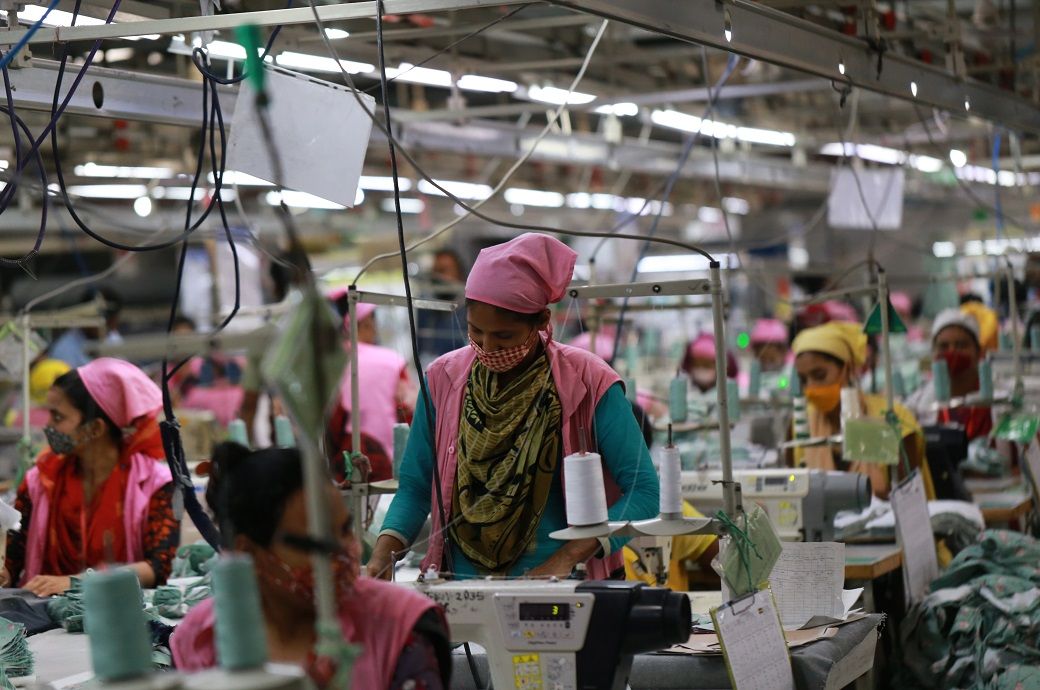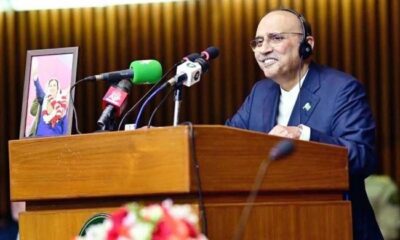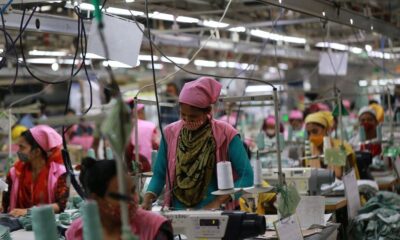Fashion
American brand Under Armour appoints Reza Taleghani as new CFO

“Dave’s leadership, financial discipline, and unwavering commitment have been instrumental in shaping Under Armour’s success and resilience over more than two decades,” said Kevin Plank, Under Armour President and CEO. “As we enter a crucial time for the brand, we are deeply thankful for his many contributions and his partnership in ensuring a smooth transition. Reza brings a global perspective, strong financial expertise, and a strategic mindset that align perfectly with our goals for Under Armour’s next chapter. His leadership will be essential as we strengthen our foundation, drive growth, and unlock the full potential of our brand for athletes and shareholders around the world.”
Under Armour has appointed Reza Taleghani as EVP and CFO, effective February 2026, succeeding long-time CFO David Bergman, who will stay through Q1 FY2027 for transition.
Taleghani joins from Samsonite, where he led major financial and operational improvements.
He brings over 25 years of global finance experience to support Under Armour’s next growth phase.
“I am honored to join Under Armour at such a significant and energizing moment in its growth,” said Reza Taleghani. “This is an iconic company with a strong foundation, a passionate team, and an unwavering focus on performance and innovation. I look forward to working closely with Kevin and the leadership team to advance our strategic priorities, improve financial results, and create long-term value for our teammates, athletes, and shareholders.”
Reza Taleghani – Background
Mr. Taleghani has more than twenty-five years of global financial and operational leadership experience. He joins Under Armour from Samsonite Group S.A., where he has served as EVP and CFO since 2018, overseeing global finance, accounting, investor relations, treasury, internal audit, and mergers and acquisitions. During his tenure, he led major financial and operational transformations, resulting in record gross margins and EBITDA margins.
Before joining Samsonite, Mr. Taleghani served as President and CFO at Brightstar Corp., a SoftBank portfolio company, where he led its device protection and financial services divisions and managed key international acquisitions. He spent over 15 years at J.P. Morgan, holding senior roles in investment banking, commercial banking and asset management, and served as President and CEO of Sterling Airlines A/S in Copenhagen. Mr. Taleghani earned a JD/MBA from Villanova University and dual bachelor’s degrees from Brown University.
Note: The headline, insights, and image of this press release may have been refined by the Fibre2Fashion staff; the rest of the content remains unchanged.
Fibre2Fashion News Desk (RM)
Fashion
Bangladesh garment makers eye $5 bn more in exports post policy tweak

Under this arrangement, the buyer supplies raw materials like fabrics and accessories. Manufacturers receive only the cutting and making charges.
Bangladesh apparel manufacturers expect an additional $5 billion from high-end garment exports in the first year after the government scraps the 50-per cent ceiling on free-of-charge (FoC) imports, trade body BGMEA said.
Under this arrangement, the buyer supplies raw materials.
The additional earnings could cross $10 billion in the second year once the FoC quota is fully abolished, BGMEA noted.
The additional earnings could cross $10 billion in the second year once the FoC quota is fully abolished, Chowdhury said.
The country’s Ministry of Commerce has decided to amend the Import Policy Order within the next two weeks, allowing garment exporters to source all raw materials from overseas buyers, process them and ship the finished products back, the Chief Adviser’s Office said.
Exporters now are permitted to import only half of the required raw materials under the FoC arrangement.
A few years ago, FoC imports were capped at 33 per cent of total raw materials. This was raised to 50 per cent later.
Bangladesh’s apparel exporters use FoC for less than 5 per cent of total shipments now due to restrictive conditions and reported complications at the Chattogram customs department.
As FoC is straightforward, less risky and faster, garment exporters feel without any quota on FoC import, global brands will place more orders with Bangladesh.
Manufacturers say orders for high-end man-made fibre and polyester garments are shifting from China to Bangladesh as the United States has imposed higher tariffs on Chinese goods.
Many Bangladeshi factories, however, cannot take full advantage of this as these are barred from importing more than half of raw materials under the current FoC regulations.
Chowdhury said FoC reduces risk as buyers cover raw material costs and cannot abruptly cancel orders, according to domestic media outlets.
However, Showkat Aziz Russell, president of the Bangladesh Textile Mills Association (BTMA), said the government should consult all stakeholders before taking any decision. He believes higher import of raw materials could harm the domestic textile industry by reducing demand for local yarn, fabrics and accessories, and lowering local value addition.
Fibre2Fashion News Desk (DS)
Fashion
EU Commission grants over $414 mn for 132 clean transition projects

The allocated amount represents more than half of the €536 million total investment needs for these projects—the remainder coming from national, regional and local governments, public-private partnerships, businesses and civil society organisations.
The European Commission has granted over €358 million (~$414.2 million) to 132 new projects across Europe under the LIFE Programme for environment and climate action.
It will mobilise €133 million (the EU will provide €76 million) to contribute to circular economy and improving quality of life, with 31 projects backing the transition to a clean, circular, energy-efficient and climate-resilient economy.
LIFE projects play a significant role in the Eurioean Union’s (EU) transition to a clean, circular and resilient economy, helping safeguard and restore the EU’s biodiversity, supporting industrial competitiveness and contributing to the EU’s long-term goal of becoming climate-neutral by 2050.
This investment will have a lasting impact on the region’s environment, economy, industry and the well-being of all Europeans. The projects will cover all areas of the LIFE programme.
It will mobilise €133 million (of which the EU will provide €76 million) to contribute to circular economy and improving quality of life, with 31 projects supporting the transition towards a clean, circular, energy-efficient, and climate-resilient economy.
It will mobilise €96 million (of which the EU will provide €58 million) to 19 projects to strengthen climate resilience and mitigation efforts.
It will also mobilise €82 million (of which the EU will provide €77 million) to 48 projects aimed at accelerating the clean energy transition, an official release said.
Among the 31 projects selected to promote a more circular economy and quality of life, the €3.6 million LIFE Woodmer project in Sweden will produce biopolymers from waste wood to reduce hazardous chemicals and plastics in packaging and textiles.
The €1.9 million project InBioSoil in Spain uses fungi to clean up soil contaminated with persistent organic pollutants.
To ensure a clean energy transition, the 48 new projects announced today range from citizen-led local energy cooperatives to retrofitting old buildings and installing affordable heat pumps. They include the €1.2 million LIFE SUNACADEMY project, a new renewable energy training academy in France, with a focus on residential and large solar installations.
The €1.8-million NESOIplus project will provide for clean energy solutions and capacity building targeted to remote island communities in the Azores, Canaries and Martinique. And with a budget of €1.6 million, the BAIL-RENOV project will give an increased focus on landlord’s needs all along the energy renovation process in rental properties in France.
Over its 33 years of existence, the LIFE Programme has co-financed more than 6,500 environmental and climate action projects across the EU and associated countries.
The present LIFE programme started in 2021 and runs until 2027, with a budget of €5.43 billion. The grants financed under the LIFE Programme are managed by CINEA, the European Climate Infrastructure and Environment Executive Agency.
Fibre2Fashion News Desk (DS)
Fashion
Fed to cut rates in Dec, forecasts GSR; US job market weakness genuine

Seeing ‘genuine’ signs of weakness in the US job market, it does not expect the picture to change enough by the December meeting for the Federal Open Market Committee (FOMC) to stop cutting.
Goldman Sachs Research recently forecast that the US Federal Reserve will cut interest rates again in December.
Seeing ‘genuine’ signs of weakness in the US job market, it does not expect the picture to change enough by the December meeting for the Federal Open Market Committee to stop cutting.
It also expects two 25-basis-point cuts in March and June next year to a terminal rate of 3-3.25 per cent.
Though Fed chair Jerome Powell was more hawkish than expected during the central bank’s recent press conference, Goldman Sachs Research still expects policymakers to lower their target rate again this year.
It also expects two 25-basis-point cuts in March and June next year to a terminal rate of 3-3.25 per cent, it said in an insights article on its website.
The FOMC cut its target rate in October for the second time this year, lowering the fed funds rate by 25 basis points to 3.75-4 per cent. The Fed also said it would stop running off its $6.6-trillion balance sheet at the start of December. The principal payments of mortgage backed securities will only be reinvested into Treasury bills.
While most official economic data releases have been suspended by the government shutdown, Powell noted that the available official and alternative indicators suggest that inflation (net of tariff effects) is now close to the 2-per cent target and that the labour market has continued to cool gradually.
The FOMC’s summary of economic projections for September implied that most participants saw a December cut as the baseline, according to Goldman Sachs Research. The Fed’s past packages of risk management cuts (proactive rate cuts to guard against potential risks to the economy) also suggest that a third and final cut is the default.
Labor market data are “unlikely to send a convincingly reassuring message” by the time of the FOMC meeting in December, David Mericle, chief US economist, wrote in the team’s report.
Deferred resignations of government employees instigated by the Department of Government Efficiency are likely to generate a negative payrolls report in October and “weigh a bit on November,” Mericle added.
Fibre2Fashion News Desk (DS)
-

 Business1 week ago
Business1 week agoAndy Jassy Reveals Real Reason Behind Amazon 14,000 Job Cuts — And It’s Not AI
-

 Sports1 week ago
Sports1 week agoTudor’s Juve exit means McKennie must prove himself all over again
-

 Politics1 week ago
Politics1 week agoPolitical violence kills almost 300 since Hasina’s fall: rights group
-

 Politics1 week ago
Politics1 week agoIran vows to rebuild nuclear sites ‘stronger than before’
-

 Tech1 week ago
Tech1 week agoStep Away From Screens With the Best Family Board Games
-

 Sports1 week ago
Sports1 week agoPakistani runners make their mark at Istanbul Marathon
-

 Entertainment1 week ago
Entertainment1 week agoPresident Zardari to attend Second World Summit for Social Development in Doha
-

 Sports1 week ago
Sports1 week agoDyche fumes at Man Utd goal, calls for VAR change

















